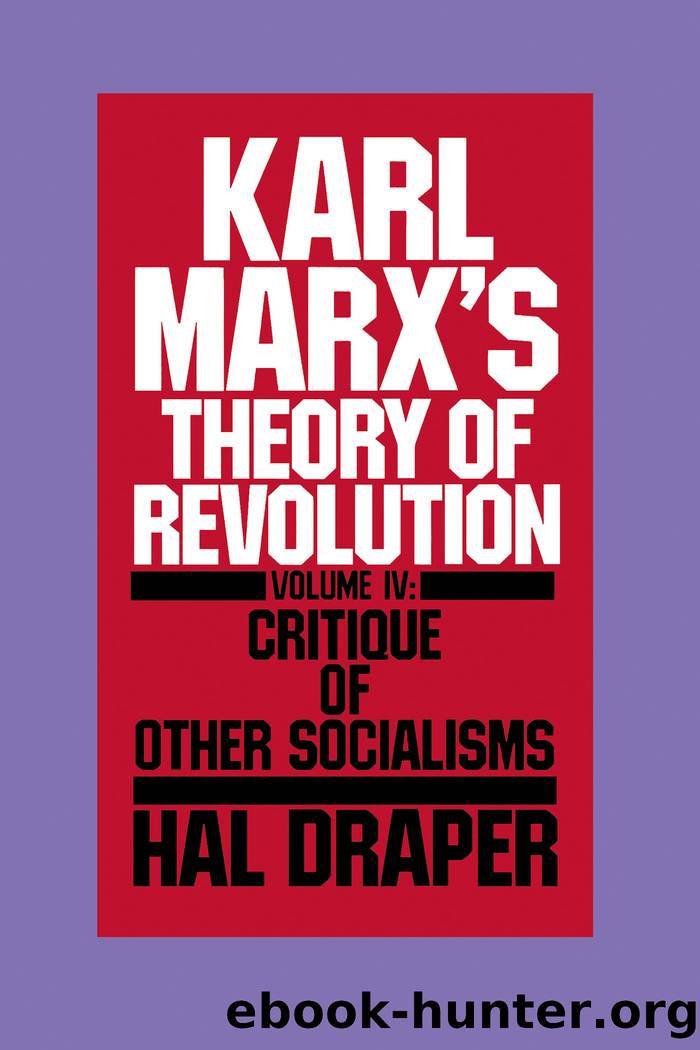Karl Marx's Theory of Revolution Vol IV by Hal Draper

Author:Hal Draper [Draper, Hal]
Language: eng
Format: epub
Tags: Communism; Post-Communism & Socialism, Political Science, Politics, Political Ideologies
ISBN: 9780853457985
Barnesnoble:
Goodreads: 184164
Publisher: Monthly Review Press
Published: 1989-01-01T00:00:00+00:00
3. THE THIRD CORNER OF THE TRIANGLE
But in the Manifestoâs section on âFeudal Socialismâ the main examples were not tendencies inside the socialist movement at all. The passage quoted above (âloud and irreverent laughterâ) was followed by this: âOne section of the French Legitimists and âYoung Englandâ exhibited this spectacle.â22 It was a question of social appeals emanating from aristocratic circles, circles reflecting prebourgeois values.
Shortly before writing the Manifesto, Marx had had to criticize âThe Communism of the Rheinische Beobachter,â an organ of the Prussian reaction. He pointed the finger at absolutist propaganda that was considered antibourgeois, and to which the communist label was being attached, just because it proclaimed that the monarchy was âone with the peopleâ in calling for social reform. Some socialists were being taken in:
If a certain section of German socialists has continually blustered against the liberal bourgeoisie, and has done so in a manner which has benefited nobody but the German governments, and if at present government newspapers like the Rheinische Beobachter, basing themselves on the empty phrases of these people, claim that it is not the liberal bourgeoisie but the government which represents the interests of the proletariat, then the Communists have nothing in common with either the former or the latter.23
Almost two decades later, Marx referred back to this very article when he broke with the Lassalleans as the representatives of âroyal Prussian government socialism.â In 1847 Engelsâ draft pamphlet, as cited above, had pointed to the same movements as exemplifications of Feudal Socialism: âthe French Legitimists or Young England.â24
In France the Legitimist champions of the overthrown Bourbon monarchy were quite willing to attack the Louis Philippe regime from the âleft,â or from any other direction. So Heinrich Heine pointed out in brilliant journalism, which was a model for Marx as for a whole generation:
It is amusing beyond words [wrote Heine] to hear these masked priests vociferating in the language of the sansculottes, to watch the coquettish air of savagery with which they sport the red caps of the Jacobins, to note how at times they are seized with a panic lest in a fit of absentmindedness they should have donned the bishopâs red cap instead. When this happens, they will remove the borrowed headgear for a moment, to make sure, and everyone can see the tonsure it was hiding.25
âYoung Englandâ had already petered out as a political group by the time the Manifesto was written, but in the early 1840s it had made a stir, under the leadership of Lord John Manners. Its best-known spokesman was the young Disraeli, whose novels Sybil and Coningsby can be read as textbooks of the school. Its most effective legislator was Lord Ashley (the later Lord Shaftesbury), who played an important part in winning factory laws. These Tory scions of the aristocracy had an idealistic aim: to counteract the rising bourgeoisie and regenerate the power of the aristocracy by appealing to the working classes of the factories and farms, not simply by social demagogy but by real amelioration of the workersâ lotâexclusively at the expense of the rival ruling classes.
Download
This site does not store any files on its server. We only index and link to content provided by other sites. Please contact the content providers to delete copyright contents if any and email us, we'll remove relevant links or contents immediately.
| Anarchism | Communism & Socialism |
| Conservatism & Liberalism | Democracy |
| Fascism | Libertarianism |
| Nationalism | Radicalism |
| Utopian |
The Secret History by Donna Tartt(18694)
The Social Justice Warrior Handbook by Lisa De Pasquale(12069)
Thirteen Reasons Why by Jay Asher(8716)
This Is How You Lose Her by Junot Diaz(6689)
Weapons of Math Destruction by Cathy O'Neil(6068)
Zero to One by Peter Thiel(5618)
Beartown by Fredrik Backman(5533)
The Myth of the Strong Leader by Archie Brown(5358)
The Fire Next Time by James Baldwin(5185)
How Democracies Die by Steven Levitsky & Daniel Ziblatt(5083)
Promise Me, Dad by Joe Biden(5029)
Stone's Rules by Roger Stone(4981)
100 Deadly Skills by Clint Emerson(4785)
A Higher Loyalty: Truth, Lies, and Leadership by James Comey(4768)
Rise and Kill First by Ronen Bergman(4643)
Secrecy World by Jake Bernstein(4584)
The David Icke Guide to the Global Conspiracy (and how to end it) by David Icke(4539)
The Farm by Tom Rob Smith(4397)
The Doomsday Machine by Daniel Ellsberg(4366)
